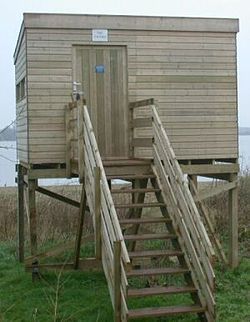Belvide Reservoir
| Belvide Reservoir | |
|---|---|

The 'Gazebo' hide at the West Midland Bird Club's Belvide Reservoir reserve
|
|
| Location | South Staffordshire |
| Coordinates | 52°41′10″N 2°11′35″W / 52.686°N 2.193°WCoordinates: 52°41′10″N 2°11′35″W / 52.686°N 2.193°W |
| Type | Canal reservoir |
| Basin countries | United Kingdom |
| Managing agency | British Waterways |
| Designation | SSSI |
| Built | 1833 |
| Surface area | 737,000 square metres (182 acres) |
| Water volume | 2,196,000 cubic metres (483×106 imp gal) |
| Website | westmidlandbirdclub |
Belvide Reservoir is a reservoir in South Staffordshire, England. It was built in 1833 to supply the Birmingham and Liverpool Junction Canal, and has been managed as a nature reserve since 1977. It has been used to study the effect of water level changes on bird populations.
Owned by the Canal & River Trust, the reservoir was constructed around 1833 to feed the Birmingham and Liverpool Junction Canal, which became part of the Shropshire Union Canal in 1846. Work began on it in 1832, and the canal opened in early 1835. Traffic levels were high, and the company had to buy 2,000 lockfulls of water in the first year, for which they paid £800 to the Wyrley and Essington Canal. In 1836, there was still pressure on the water supply, and the engineer William Cubitt was instructed to enlarge the reservoir in May. In order to finance the improvements, the Commissioners agreed that they would not be paid until £20,000 had been spent on the improvements. The enlarged reservoir was completed in 1842. The valve gear which controls the flow of water from the reservoir to the canal is believed to be original. It is housed in a circular gear house which stands in front of a concave brick retaining wall. Both were designed by Thomas Telford, and are Grade II* listed structures. The structure has a cast iron dome, and is a rare example of an original valve house. The reservoir covers an area of 180 acres (73 ha) when water levels are at their highest, but levels fluctuate as water is used for the canal, and the surface area is around half of this figure when the water level is 12 feet (3.7 m) lower. The reservoir is fed by a tributary of the River Penk.
It is the site of a nature reserve, which has been operated by the West Midland Bird Club since January 1977, and is designated a Site of Special Scientific Interest (SSSI). The reserve is not open to the general public, and a permit is required to visit it.
...
Wikipedia
